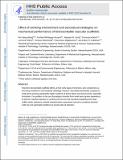Effect of working environment and procedural strategies on mechanical performance of bioresorbable vascular scaffolds
Author(s)
Wang, Peijiang; Rikhtegar Nezami, Farhad; Gorji Bandpay, Maysam; Berti, Francesca; Petrini, Lorenza; Wierzbicki, Tomasz; Migliavacca, Francesco; Edelman, Elazer R; ... Show more Show less
DownloadAccepted version (1.064Mb)
Publisher with Creative Commons License
Publisher with Creative Commons License
Creative Commons Attribution
Terms of use
Metadata
Show full item recordAbstract
Polymeric bioresorbable scaffolds (BRS), at their early stages of invention, were considered as a promising revolution in interventional cardiology. However, they failed dramatically compared to metal stents showing substantially higher incidence of device failure and clinical events, especially thrombosis. One problem is that use of paradigms inherited from metal stents ignores dependency of polymer material properties on working environment and manufacturing/deployment steps. Unlike metals, polymeric material characterization experiments cannot be considered identical under dry and submerged conditions at varying rates of operation. We demonstrated different material behaviors associated with variable testing environment and parameters. We, then, have employed extracted material models, which are verified by computational methods, to assess the performance of a full-scale BRS in different working condition and under varying procedural strategies. Our results confirm the accepted notion that slower rate of crimping and inflation can potentially reduce stress concentrations and thus reduce localized damages. However, we reveal that using a universal set of material properties derived from a benchtop experiment conducted regardless of working environment and procedural variability may lead to a significant error in estimation of stress-induced damages and overestimation of benefits procedural updates might offer. We conclude that, for polymeric devices, microstructural damages and localized loss of structural integrity should complement former macroscopic performance-assessment measures (fracture and recoil). Though, to precisely capture localized stress concentration and microstructural damages, context-related testing environment and clinically-relevant procedural scenarios should be devised in preliminary experiments of polymeric resorbable devices to enhance their efficacy and avoid unpredicted clinical events. Statement of Significance: Bioresorbable scaffolds (BRS) with the hope to become the next cardiovascular interventional revolution failed in comparison to metal stents. When BRS were characterized using methods for metal stents, designers were misled to seek problem sources at erroneous timeframe and use inefficient indicators, and thus no signal of concern emerged. We demonstrated fundamental flaws associated with applying a universal set of material properties to study device performances in different phases of manufacturing/implantation, and these may be responsible for failure in predicting performance in first-generation BRS. We introduced new criterion for the assessment of structural integrity and device efficacy in next-generation BRS, and indeed all devices using polymeric materials which evolve with the environment they reside in.
Date issued
2018-10Department
Massachusetts Institute of Technology. Center for Biomedical Engineering; Massachusetts Institute of Technology. Institute for Medical Engineering & Science; Massachusetts Institute of Technology. Impact and Crashworthiness Laboratory; Massachusetts Institute of Technology. Department of Mechanical EngineeringJournal
Acta Biomaterialia
Publisher
Elsevier BV
Citation
Wang, Pei-Jiang, et al. "Effect of working environment and procedural strategies on mechanical performance of bioresorbable vascular scaffolds." Acta Biomaterialia 82 (December 2018): 34–43. doi:10.1016/j.actbio.2018.10.020.
© 2018 Author(s)
Version: Author's final manuscript
ISSN
1742-7061
1878-7568